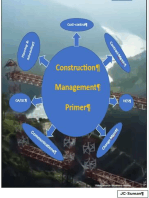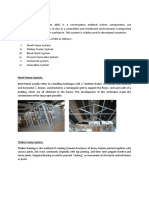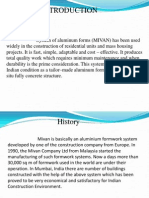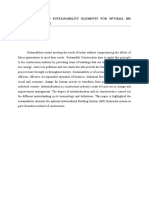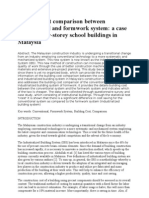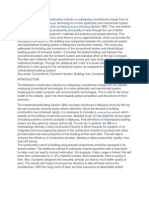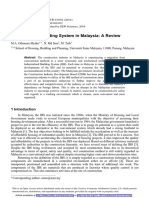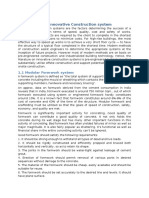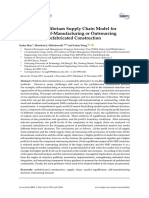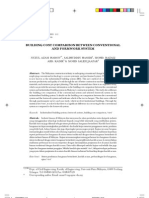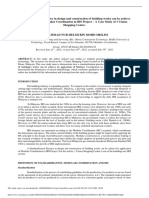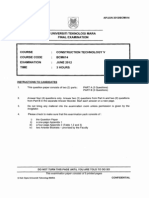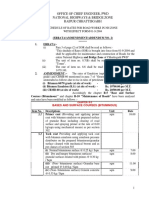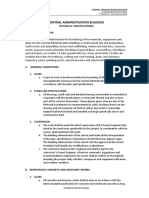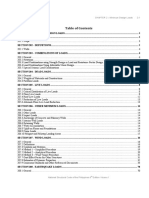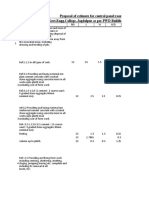A Study of Precast Concrete in Malaysia: Setting Up
A Study of Precast Concrete in Malaysia: Setting Up
Uploaded by
nuafzanCopyright:
Available Formats
A Study of Precast Concrete in Malaysia: Setting Up
A Study of Precast Concrete in Malaysia: Setting Up
Uploaded by
nuafzanOriginal Description:
Original Title
Copyright
Available Formats
Share this document
Did you find this document useful?
Is this content inappropriate?
Copyright:
Available Formats
A Study of Precast Concrete in Malaysia: Setting Up
A Study of Precast Concrete in Malaysia: Setting Up
Uploaded by
nuafzanCopyright:
Available Formats
PRECAST CONCRETE
A study of precast concrete
in Malaysia
Malaysia has attempted to transform its conventional method of construction to prefabrication using
industrialised building systems (IBS) and changing productivity from project based into product based. The
most common IBS component used in Malaysia is precast concrete. This article describes a qualitative study
conducted on 15 decision makers from 25 Malaysian precast manufacturers registered with the
Construction Industry Development Board (CIDB).
Mohamed Nor Azhari Azman, Sultan Idris Education University, Tanjong Malim;
Mohd Sanusi S Ahamad and Taksiah A Majid, Universiti Sains Malaysia, Nibong Tebal;
Mohd Nazree Shah Anwar Shah, Wisma Global Globe, Kuala Lumpur; all Malaysia
n line with current housing demands in
the global market, the construction industry has shifted its focus to mass production assembly and standardising product
development. This strategy has prompted
the Malaysian construction industry to reevaluate the achievements of other countries in implementing prefabricated technology, such as the UK, Australia, Singapore
and Hong Kong.
Prefabrication technology in Malaysia
is called IBS, alternatively known as modern methods of construction (MMC) or
off-site manufacturing (OSM). Azman et
al(1) reported that the IBS concept is similar to MMC in the UK. OSM is used both in
Australia and the UK construction industry,
while prefabrication is used in Hong Kong
and Singapore.
IBS has been promoted since the 1960s
but the construction industry in Malaysia
has stuck to conventional methods. This
had a negative impact and delay in the
were interpreted and coded into an effective number of categories. Currently, 25 IBS
precast manufacturers are registered with
the CIDB in Malaysia. A population survey
was conducted through interviews with 15
decision makers (top management level)
from precast manufacturing plants with five
years experience in IBS work.
Table 1 Categorisation of off-site system
Countries Categorisation
Off-site preassembly
Hybrid system
US
Panellised system
Modular building
Component manufacture and
subassembly
UK
Non-volumetric preassembly
Volumetric preassembly
Modular building
Non-volumetric preassembly
Australia Volumetric preassembly
Modular building
Precast concrete systems
Formwork systems
Steel framing systems
Malaysia Prefabricated timber framing
systems
Block work systems
Innovative product systems
Source: Azman et al (2010)
Setting up
Figure 1: Relative frequency of themes in
setting up precast manufacturing.
implementation of projects. Hence, in
1994 the Malaysian Government set up the
Construction Industry Development Board
(CIDB) to educate the industry.
Since 1998, CIDB had implemented the
IBS Score to measure the level of IBS usage
in building. Based on CIDB requirements, all
public buildings are required to achieve a
minimum of 70% IBS Score, while for private
residential buildings, contractors need to
acquire a minimum of 50% to have exemption from the construction levy for projects.
The scoring system is in accordance with the
principles of standardised usage of prefabricated and IBS components, repeatability
and design building components based on
Malaysian Standard1064(2). Consequently,
there has been a high demand for precast
concrete among contractors and a qualitative survey was carried out to study the
establishment of precast manufacturing
sites and the criteria for setting up such
plant.
Methodology
The research methodology applies a qualitative approach through a series of interviews and observation. The collected data
50 Concrete Engineering International October 2012
The coding data of 15 respondents have
determined the relative frequency of four
main themes in setting up precast manufacturing (Figure 1). The relative frequency
themes are able to describe the rudimentary
measurement of the relative importance of
the precast manufacturing industry:
Appropriate technology
The appropriate IBS technology for the
construction industry in Malaysia is hybridisation a combination of a small partial
conventional method with mechanisation
technology. It reflects the latest IBS classification of innovative systems. Together,
the Government and the research scholars
have produced a guideline on the off-site
system. The categories, pattern and the
degree of technology changes are described
in Table 1.
Transportation/erection
The size and weight of completed precast units may limit the design and these
aspects need careful design consideration.
The length of a volumetric unit should not
exceed 12m, the normal vehicle length. The
IBS components height should not exceed
4.5m when loaded on the trailer; the components could not enter the highway system if
they exceed a height limitation ranging from
4.8 to 5.1m. The precast concrete component should not exceed 7 tonnes to ensure
that a crane can easily erect and transport
the material on-site. The suitable distance of
any potential development area to the fabri-
PRECAST CONCRETE
cation plant should be from 50 to 100km, based on the study made
by Warszawski(3). It is also important to have the precast concrete
in parts. This partial size can be plugged and played to enhance
the effectiveness for the erection of the IBS components. Figure 2
shows the typical sequences of the IBS working system.
All IBS components are built with hooks for easy handling and
erection as shown in Figure 3. The lifting and installation of IBS
component units requires a high level of skill and careful safety
planning. The lifting points should be matched to the distribution
of the weight of the unit to ensure that the item will be lifted on a
level plane.
Design and build
The best practice tender award for IBS system is design and build.
The design-and-build method is able to control the whole project
flow, especially during the construction period, with less changes
in the design stage.
Under the IBS method, M&E drawings must be prepared in the
early stages. The process requires consultation with the client to
finalise the design. The effectiveness of the IBS drawing helps to
eliminate redundancy in conventional works, especially during the
superstructure stage.
Construction workers
Most of the developed countries are keen to reduce foreign workers input in their production of commodities. IBS implementation
can be part of the strategy of labour reduction and effective training to acquire local skills. Therefore, with the IBS implementation,
Malaysia has reduced the number of foreign workers by 4% in 2006
and is able to better educate the industry on the appropriate use of
IBS technology and systematic work to gain the same productivity
with better outcomes.
Concrete Engineering International October 2012 51
PRECAST CONCRETE
Figure 2 left: Typical IBS system
sequence of works.
Figure 3 right: Hooks of the IBS
components.
Figure 4 below: Typical mobile
model of precast manufacturing
plant.
Results
The end result of the content
analysis has proposed 11 criteria
for permanent and mobile precast manufacturing plants. The
significant difference between
permanent and mobile precast
manufacturing is the movability of
the precast manufacturing plant.
The main structure of permanent
precast manufacturing is a permanent building with full cover,
shaded or semi-shaded to provide protection from weather conditions, while mobile
precast manufacturing has a contrasting
physical structure as shown in Figure 4.
The detailed comparison of permanent and
mobile precast manufacturing is illustrated
in Table 2(4).
Conclusion
Table 2 The comparison of permanent and mobile precast manufacturing
Criteria
Permanent manufacturing
Mobile manufacturing
Annual project
Capital
Technology
Maintenance
RM100 million above (US$33m)
High
Prefabricated, semi-auto, automatic
High maintenance:
High electricity bill
Minimum 15 acres
Flexible size
Permanent
Protected from rain
RM10 million above (US$3m)
Low
Prefabricated
Low maintenance:
Low electricity bill
Can start with 5 acres
Flexible size
Mobile
Develop portable roofing to
protect the concrete
25 workers
Multi-tasking
Low payment
Half slab
Staircase
Beam
Column
Wall panel
Land capacity
Mould
Roof of IBS
Manufacturing
Manpower
Product
Crane
Concrete
Maximum 500 workers
Specific task
High payment
Hollowcore slab
Half slab
Staircase
Beam
Column
Wall panel
Permanent
At factory: 2530 tonnes
At site: 50260 tonnes
Required batching plant concrete
Source: Azman et al(4)
52 Concrete Engineering International October 2012
Permanent or mobile
At factory: 2530 tonnes
At site: 50260 tonnes
Outsource or set up a new
batching plant
Prefabrication has been successfully used in
the manufacture and construction of houses
and multi-storey industrial buildings.
The main parameters affecting the setting up of precast manufacturing factories
are: appropriate technology; capability of
transportation and erection of IBS components; best practice in design and build; and
skilled workers.
Appropriate technology is vital in accelerating the development of a country and
represents major factor in setting up precast
manufacturing.
In addition, this study presents an outlook
of 11 criteria for setting up precast manufacturing site plants, ie, permanent or mobile
manufacturing. The results have provided
an indication that the construction industry
must move towards new criteria.
The IBS technology must be affordable
and future research should be continued for
the benefit of the construction industry.
Further information:
More details on the IBS Score can be found at:
www.ibscentre.com.my
References
1. AZMAN, M.N.A., AHAMAD, M.S.S., MAJID, T.A.
and HANAFI, M.H. The Common Approach in OffSite Construction Industry. Australian Journal
of Basic and Applied Sciences, Vol.4, No.9,
pp.44784482, September 2010.
2. DEPARTMENT OF STANDARDS MALAYSIA,
MS 1064. Guide to Modular Coordination in
Buildings: Part 1: General Principles. Standards
Malaysia, Kuala Lumpur, Malaysia, 2001.
3. WARSZAWSKI, A. Industrialized and Automated
Building Systems. E & FN Spon, London, 1999.
4. AZMAN, M.N.A., AHAMAD, M.S.S., MAJID,
T.A. and HANAFI, M.H. Permanent and Mobile
Industrialised Building System Manufacturing
Plant Based on Malaysian Case Study.
Proceedings of the World Conference on
Information Technology, Antalya, Turkey,
Academic World Education & Research Center,
2011.
You might also like
- LNG JettyDocument17 pagesLNG Jettywilliam pasamonteNo ratings yet
- 5 Stages To Promote IBS in MalaysiaDocument3 pages5 Stages To Promote IBS in MalaysiasyakirohNo ratings yet
- CONCRETE (Material Science & Metallurgy)Document26 pagesCONCRETE (Material Science & Metallurgy)Shuvas KhanalNo ratings yet
- Industrialised Building SystemDocument87 pagesIndustrialised Building SystemOo Nana MarshumellowNo ratings yet
- The Potential Application of IBS Modular System in TheDocument8 pagesThe Potential Application of IBS Modular System in TheJudy TanNo ratings yet
- IbsDocument4 pagesIbsMohd Fazli LajakNo ratings yet
- Industrialised Building SystemDocument4 pagesIndustrialised Building SystemMuazan MahbolNo ratings yet
- Journal 563Document5 pagesJournal 563MAXSWELL MANGGIE ZAMRYNo ratings yet
- What Is IBSDocument7 pagesWhat Is IBSqadiejaNo ratings yet
- 1 RoadMap IBSDocument83 pages1 RoadMap IBSazcompNo ratings yet
- Industrialised Building System (IBS)Document54 pagesIndustrialised Building System (IBS)RuzainiAnnuar90% (10)
- Construction Cost ComparisionDocument7 pagesConstruction Cost ComparisionmrlobboNo ratings yet
- Assignment IBSDocument13 pagesAssignment IBSEsya Iman0% (1)
- W5a-IBS - Precast Technology-1Document56 pagesW5a-IBS - Precast Technology-1Khairun NishaNo ratings yet
- Mi VanDocument37 pagesMi Vankaran9027No ratings yet
- Identification of Sustainability Elements For Optimal Ibs System Formwork (Bab 1-Bab 2)Document27 pagesIdentification of Sustainability Elements For Optimal Ibs System Formwork (Bab 1-Bab 2)Bayau Fendi باياو فندي50% (2)
- Modular For High Rise in KoreaDocument10 pagesModular For High Rise in KoreaYunita MentariNo ratings yet
- Building Cost Comparison Between Conventional and Formwork SystemDocument9 pagesBuilding Cost Comparison Between Conventional and Formwork SystemNurul Arafah IshakNo ratings yet
- Study On The Use of Industrialised Building System (IBS) in Malaysian Private Construction ProjectsDocument8 pagesStudy On The Use of Industrialised Building System (IBS) in Malaysian Private Construction ProjectsAsyraf JagungNo ratings yet
- Modern Methods of Construction Ijariie10601Document28 pagesModern Methods of Construction Ijariie10601Aanchal AroraNo ratings yet
- IBS RoadmapDocument24 pagesIBS RoadmapmisswanyNo ratings yet
- Comparitive Study Between Prefab and Traditional MethodDocument8 pagesComparitive Study Between Prefab and Traditional MethodSandeep SharmaNo ratings yet
- Industrialised Building System in Malaysia A RevieDocument9 pagesIndustrialised Building System in Malaysia A RevieJudy TanNo ratings yet
- Introduction of Innovative Construction SystemDocument3 pagesIntroduction of Innovative Construction Systemgarima0303No ratings yet
- 2017 - A Market Equilibrium Supply Chain ModelDocument18 pages2017 - A Market Equilibrium Supply Chain ModelAlejandroNo ratings yet
- 5 - Kamar, Hamid and Alshawi (2010)Document13 pages5 - Kamar, Hamid and Alshawi (2010)Ayush KhareNo ratings yet
- Comparison FormworkDocument11 pagesComparison FormworkIrma86abidinNo ratings yet
- Lecture 01_Intro to IBSDocument54 pagesLecture 01_Intro to IBSWAN MOHAMAD FARIS (Ӝ)No ratings yet
- IBSDocument13 pagesIBSMohd Isa Aziz JaafarNo ratings yet
- MCDocument12 pagesMCstigNo ratings yet
- Automation in Construction: Matthew Goh, Yang Miang Goh TDocument18 pagesAutomation in Construction: Matthew Goh, Yang Miang Goh TJuan Camilo Aldana BarreraNo ratings yet
- Methodstatement of Precast Concrete BuildingDocument2 pagesMethodstatement of Precast Concrete BuildingRi SovannaphumiNo ratings yet
- Understanding Open System in IBSDocument4 pagesUnderstanding Open System in IBSNg Chia ShenNo ratings yet
- Exploration of Prefabricated Building SyDocument13 pagesExploration of Prefabricated Building SyNouman MohsinNo ratings yet
- Implementation of Prefabrication and Modular Offsite Construction Using BIM and Lean Construction TechniquesDocument8 pagesImplementation of Prefabrication and Modular Offsite Construction Using BIM and Lean Construction Techniquessagasfn94No ratings yet
- Journal of Building Engineering: Maryam Shahpari, Fatemeh Mehdizadeh Saradj, Mir Saman Pishvaee, Saeid PiriDocument15 pagesJournal of Building Engineering: Maryam Shahpari, Fatemeh Mehdizadeh Saradj, Mir Saman Pishvaee, Saeid PiriLeslye JackelineNo ratings yet
- Lecture 1 - Introduction to IBSDocument34 pagesLecture 1 - Introduction to IBSMuhammad IrfanNo ratings yet
- Muhammad Nur Helmi Bin Mohd Mislim 2020845232 BCT563 Assignment2 PDFDocument6 pagesMuhammad Nur Helmi Bin Mohd Mislim 2020845232 BCT563 Assignment2 PDFMAXSWELL MANGGIE ZAMRYNo ratings yet
- Precast Technology Mini Project Sid 1111Document33 pagesPrecast Technology Mini Project Sid 1111jai sri ramNo ratings yet
- Time and Cost Optimization of Construction Project Using Mivan TechnologyDocument5 pagesTime and Cost Optimization of Construction Project Using Mivan TechnologyReiza Ahfazny IskandarNo ratings yet
- Industrialized Building System in Malaysia Challenges and The Way ForwardDocument15 pagesIndustrialized Building System in Malaysia Challenges and The Way ForwardMohd Huzairi SalgimanNo ratings yet
- MR - Ksenou L&T PrecastDocument53 pagesMR - Ksenou L&T PrecastHarssh ShahNo ratings yet
- Industry Seminar ReportDocument3 pagesIndustry Seminar ReportJohnny LimNo ratings yet
- Digest: MalbexDocument8 pagesDigest: MalbexHazwan AfiqqNo ratings yet
- The Adoption of Industrialised Building System IBS Construction in Malaysia The History Policies Experiences and Lesson LearnedDocument8 pagesThe Adoption of Industrialised Building System IBS Construction in Malaysia The History Policies Experiences and Lesson LearnediwereNo ratings yet
- IBS Note Topic 1 For Polytechnic StudentDocument21 pagesIBS Note Topic 1 For Polytechnic StudentShazey HenixyNo ratings yet
- A Review On Construction of Additional Building School Using Industrialized Building System (IBS) in Sarawak, MalaysiaDocument11 pagesA Review On Construction of Additional Building School Using Industrialized Building System (IBS) in Sarawak, MalaysiaKhairul Yop AzreenNo ratings yet
- Industrialised Building System (IBS) in SarawakDocument7 pagesIndustrialised Building System (IBS) in SarawakJudy TanNo ratings yet
- Digital Ibs BrochureDocument6 pagesDigital Ibs Brochuremcwong_98No ratings yet
- UNITEN ICCBT 08 Perception of Industrialized Building System (IBS) Within TheDocument18 pagesUNITEN ICCBT 08 Perception of Industrialized Building System (IBS) Within TheAmirah AqilahNo ratings yet
- Modular CVC - Aftamend - v4Document2 pagesModular CVC - Aftamend - v4Adron LimNo ratings yet
- Industrialised Building Construction CBRIDocument20 pagesIndustrialised Building Construction CBRIAnuja JadhavNo ratings yet
- Advantages and Setbacks of Industrialized Building System (IBS) Implementation: A Case Study in SarawakDocument10 pagesAdvantages and Setbacks of Industrialized Building System (IBS) Implementation: A Case Study in SarawakAbdulrahman AlnagarNo ratings yet
- BCM614Document10 pagesBCM614Nuri AbdullahNo ratings yet
- Modernisation, Mechanisation and Industrialisation of Concrete StructuresFrom EverandModernisation, Mechanisation and Industrialisation of Concrete StructuresNo ratings yet
- Improving Energy Efficiency and Reducing Emissions through Intelligent Railway Station BuildingsFrom EverandImproving Energy Efficiency and Reducing Emissions through Intelligent Railway Station BuildingsNo ratings yet
- Mechanical Production Engineer Success: Careers, Interview Q&A, and TerminologyFrom EverandMechanical Production Engineer Success: Careers, Interview Q&A, and TerminologyNo ratings yet
- Office of Chief Engineer, PWD National Highways & Bridge Zone Raipur ChhattisgarhDocument10 pagesOffice of Chief Engineer, PWD National Highways & Bridge Zone Raipur Chhattisgarhnitin guptaNo ratings yet
- 1.1 Definition of ConcreteDocument6 pages1.1 Definition of ConcreteKavi MaranNo ratings yet
- Cofraj Pierdut Din Material Plastic Minimodulo Catalog Eng 47072Document2 pagesCofraj Pierdut Din Material Plastic Minimodulo Catalog Eng 47072Anonymous eD1l6o9ZsWNo ratings yet
- MR Vachan Singh - Tata Housing Devt CoDocument7 pagesMR Vachan Singh - Tata Housing Devt Coprozoam21No ratings yet
- Central Administration Building: Technical Specifications General DiscriptionDocument7 pagesCentral Administration Building: Technical Specifications General DiscriptionDarcy stylesNo ratings yet
- WT0709Document54 pagesWT0709gzapasNo ratings yet
- Design of Pedestrian Bridge Ground and Structures Encv4Gs MR .M.JarosDocument15 pagesDesign of Pedestrian Bridge Ground and Structures Encv4Gs MR .M.JarosnavinNo ratings yet
- Cim 800Document4 pagesCim 800Ing Ramon GonzalezNo ratings yet
- SRS ExDocument16 pagesSRS ExAdrian Ilie SerbanNo ratings yet
- @gupta - Gupta RCC With SolutionDocument803 pages@gupta - Gupta RCC With Solutionementsionjune23No ratings yet
- Concrete Highway Arch Bridges in BangladeshDocument10 pagesConcrete Highway Arch Bridges in BangladeshBridge WingNo ratings yet
- Role of Columns in Construction.....Document21 pagesRole of Columns in Construction.....Muhammad Hamza100% (1)
- Suitability of Manufacture Sand (M-Sand) As Fine Aggregate in Mortars and ConcreteDocument16 pagesSuitability of Manufacture Sand (M-Sand) As Fine Aggregate in Mortars and Concreteprs226No ratings yet
- NSCP 2010 v1 Chapter 2 - Loads and Actions - Final DraftDocument110 pagesNSCP 2010 v1 Chapter 2 - Loads and Actions - Final DraftAnonymous ncy8DzL4No ratings yet
- Checklist For Concrete Road PavementDocument5 pagesChecklist For Concrete Road PavementAshir RIZNo ratings yet
- SN3148 - Use of Limestone in Cements PDFDocument78 pagesSN3148 - Use of Limestone in Cements PDFKalindaMadusankaDasanayakaNo ratings yet
- Write Essays For CashDocument6 pagesWrite Essays For Cashurdpzinbf100% (2)
- Water ProofingDocument124 pagesWater Proofingdist2235No ratings yet
- Pre-Qualification Submittal Updated 07242023Document142 pagesPre-Qualification Submittal Updated 07242023azim.rmaxNo ratings yet
- Excavation Breaking of Concrete and Re Instatement WorkDocument5 pagesExcavation Breaking of Concrete and Re Instatement WorksujanNo ratings yet
- Cantrol Panel EstimateDocument23 pagesCantrol Panel EstimatesmitaNo ratings yet
- Chemrite NNDocument3 pagesChemrite NNghazanfarNo ratings yet
- Concrete Frame BuildingsDocument100 pagesConcrete Frame BuildingsNuwantha Uduwage100% (1)
- Hollowcore Floor Systems: The Benefits of Hollowcore FloorsDocument5 pagesHollowcore Floor Systems: The Benefits of Hollowcore Floorskundanika prasadNo ratings yet
- Mechanical Behavior of Drainage Pipes of Steel Fiber Reinforced Concrete: A Numerical ModelDocument18 pagesMechanical Behavior of Drainage Pipes of Steel Fiber Reinforced Concrete: A Numerical Modelingenauta7282No ratings yet
- Mechanical VibrationsDocument435 pagesMechanical VibrationsUtkarsh Mishra100% (2)
- Structural Engineering OverviewDocument40 pagesStructural Engineering OverviewPatrick Kelly FontanillaNo ratings yet
- Practice of Partial Prestressing For Continuous Post-Tensioned Structures in North AmericaDocument29 pagesPractice of Partial Prestressing For Continuous Post-Tensioned Structures in North AmericaJoão Paulo MendesNo ratings yet

